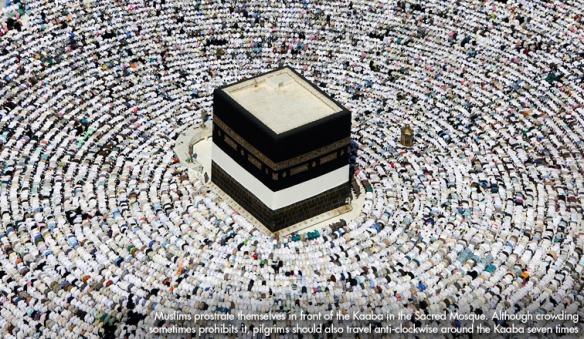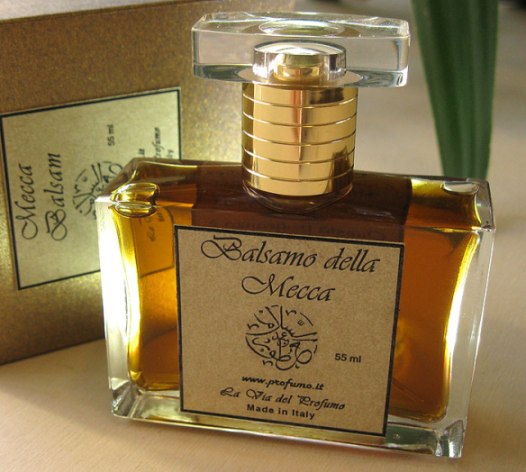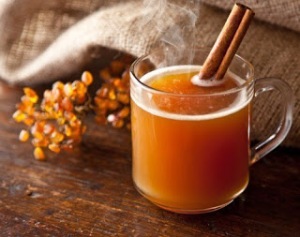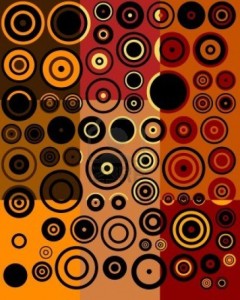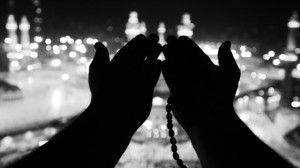The Saudi-based perfume house of Arabian Oud is one of the most prolific brands in the region, but few of their fragrances are talked about in the West other than the lovely amber oriental, Kalemat. Today, I thought I’d take a look at three of their other creations: the floriental oud perfume oil, Ghroob (sometimes spelled as “Ghoroob“); the dry, spiced, rose-saffron-oud scent called Woody; and the warm, spiced, heavily ambered oud fragrance, Misty Wood.
GHROOB:
Ghroob caught my attention when I was in Paris last year and had the opportunity to visit the Arabian Oud store. The main reason was that I had never before (or since) encountered such a powerful, potent and highly concentrated blast of orange blossom. I have a weakness for the flower, which assailed me right from the start, but Ghroob’s prettiness really lies in its subsequent stages.
Ghroob is not a perfume that you spray but, rather, is a concentrated perfume oil that you dab. Fragrantica says that its perfume pyramid is as follows:
Top notes are agarwood (oud), saffron, cinnamon, orange blossom, thyme and marjoram;
middle notes are bulgarian rose, jasmine, gardenia, palmarosa and geranium;
base notes are sandalwood, white amber, musk and vanilla.
However, according to the very kind gentleman at Arabian Oud London, Ahmed Chowdhury, who sent me my sample, Ghroob’s notes are quite different:
Top notes: Oud, Saffron, Cinnamon, Orange blossom
Heart notes: Jasmine, Gardenia, Bulgarian rose
Base notes: Sandalwood, White amber, Cambodian Oud, Musk.
Ghroob opens on my skin with very sweet, syrupy orange blossom that is infused with a black, indolic dirtiness on top and a touch of leatheriness underneath. It feels a little bit smoky, and, for a few minutes, almost verges on the camphorous in the way that very indolic flowers can sometimes be. At the same time, however, there is also a certain piquant greenness underlying Ghroob that feels almost as if the perfume contained a good dose of neroli as well. Neroli is merely another form of orange blossoms, resulting from a different method of distillation, so the overlap is not surprising.
There are other elements woven in as well. The undercurrent of greenness is supplemented by flecks of creamy gardenia that somehow manages to be clean, fresh, indolic, lush, and narcotic, all at the same time. Initially, the note is just a tiny hint in the background, one that is often lost in the sea of extremely intense, highly sweetened orange blossoms, but, as you will see, it becomes much more significant later. The green gardenia is accompanied by the lightest touch of sweet jasmine. The whole thing is lightly dusted with saffron, along with clean musk.
It’s a very intense bouquet at first, one that may easily seem screeching if you’re not a fan of Middle Eastern attars or concentrated orange blossoms. The latter are flowers in full bloom, almost verging on over-ripe at times, with an intense, heady voluptuousness. Their initial sweetness could have been toned down for my personal tastes, but I really like how brightness and almost smoky blackness are somehow juxtaposed at the same time. The undercurrent of greenness also helps to keep the orange blossoms wavering just before the border of excessive syrup, without actually falling over it.
Ghroob’s concentrated richness initially feels quite heavy, but the perfume is actually airier and lighter in weight than what you’d expect, at least once the first hour passes. As with many attars, Ghroob doesn’t have monumental projection, no matter how much of an orange blossom, floriental bomb it might be. Initially, 2 small smears create a cloud that hovers about 3 inches above my skin, but the number starts to drop with every passing half-hour.
Ghroob slowly shifts. After 30 minutes, the bitter, neroli-like green note increases, cutting even further through the sweetness, and amplifying both the brightness and the freshness of the orange blossoms. Ghroob is not a photo-realistic orange blossom scent because of the other floral notes, the saffron, and the sweetness, but I find it quite lovely.
What is interesting is the slow movement away from an indolic scent towards one that is greener, fresher, cleaner, and more balanced. At the end of the first hour, the oud rises from the base but it, too, feels quite clean. It smells primarily of a slightly singed, general woodiness, and doesn’t have any of the medicinal, earthy, musky tonalities that agarwood can sometimes manifest.
By the 90-minute mark, soft, slightly creamy warmth begins to coat the orange blossoms, as amber rises from the base. The indolic overtones are now gone, replaced by a surprising greenness, almost like the sap from freshly crushed leaf stems, and an increasingly prominent green gardenia note. Ghroob is now a softer, very fresh blend of orange blossom and gardenia, infused with greenness, woodiness, and a subtle cleanness, all lightly wrapped in a sheer cocoon of abstract amber. It hovers just above the skin, and the sillage stays there for almost 8 more hours to come.
The gardenia and greenness eventually fade away, and the start of the 4th hour heralds a Ghroob that is primarily clean orange blossom with ambered oud and a touch of clean musk. There is a certain synthetic sharpness running through the scent, which doesn’t make me happy but it’s subtle enough that I don’t think a lot of people will notice. Slowly, slowly, other elements appear as well. There is a tiny touch of vanilla that stirs in the base, while a subtle spiciness hovers like a ghost at the edges, almost out of sight. It is suggestive of sweetened cinnamon with a tiny pinch of dry saffron.
Ghroob remains largely unchanged throughout its drydown. It’s a blur of sweet, slightly golden, soft orange blossoms and clean, dry oud, with amber, abstract spices, oud, creaminess and an undercurrent of cleanness. In its final moments, almost 15.5 hours from the start, Ghroob is a faint trace of vaguely clean sweetness.
There aren’t really proper blog reviews out there for Ghroob that I could share with you for comparative purposes. However, there are a number of positive comments left about the scent in my prior review of Arabian Oud’s lovely amber scent, Kalemat. The one person who didn’t like it was a chap who hated gardenia, and that seemed to be the dominant flower on his skin, not the orange blossoms.
On Fragrantica, Ghroob has received 4 reviews, and all 4 are positive raves that call it “beautiful,” “gorgeous,” and “wonderful.” Many note that it is not a heavy fragrance at all, though I do not think you should mistake their comments to mean that the scent is light and mild. It is most certainly not. On Amazon — the main place where Ghroob is available in the U.S. and where it retails for $69 — the perfume has five 5-star reviews, all highly positive. Some of the comments:
- The most beautiful Oud Oil.. I adore it ! [¶] It’s not heavy or enormous Oud at all, it’s more on the side of (soft spice oriental Oud), the orange blossoms here are so pretty and makes the scent younger & more wearable for all ages, developed with the elegant saffron note.
- Deep and complex aroma and very beautiful. Definitely, very beautiful … mysterious. Just one drop lasts the whole day.
- Complex and deep, but not overpowering. Little bit strange at the beginning, you just need to wait for a half hour for the beauty to appear. After that soft silage and cloud of delicious smell for all day long.
- I purchased this based on one review I read and it exceeded all my expectations. It’s warm, spicy, delicate, breezy and exotic all at the same time. Just a breath of oud and a luscious blend of florals I didn’t even think I’d like. It’s the warmth of it that’s so intoxicating. A little goes a long way. I’ve been wearing this alone and mixed with mukhallats and even western perfume and its always perfection. I work with a pregnant chick who has had terrible bouts of morning sickness and can’t stomach even the scent of soap. She’s been following me around for days telling me how it’s the best stuff she ever smelled and the only thing tht doesn’t make her diZzy. As for longevity, my skin drinks up fragrance but this stuff lingers! My days are 8am til 10pm most days and I still smell it when I come home. People at work commented at how they know I’ve been on the elevator or in a certain hallway. All in a good way bc even though this stuff lasts, it’s not heady or cloying, just regal. I love it and can’t wait for my next bottle! Way to go arabian oud. I have killian oud, Tom ford galore and various others but this is the one I keep turning to. It’s only 25 ml but a little goes a long way and for this price, its a steal. [Emphasis to other names added by me.]
If you love intense orange blossoms and floral orientals, then Ghroob is definitely one for you to try.
WOODY:
Woody is a very traditional Middle Eastern fragrance that is initially centered on the conventional saffron-rose-oud combination before eventually turning into a dry, lightly sweetened, woody fragrance with some ambered warmth.
According to Arabian Oud on its Amazon website, Woody’s notes are simple:
Aged oud, rose, patchouli, dry amber and musk.
Woody opens on my skin with saffron, rose, and oud, infused heavily with very jammy, fruited patchouli. The heavy saffron touch smells fiery, dusty, buttery, and nutty, all at once. By its side is the velvety, rich, blood-red, fruit-chouli rose. Trailing behind, and not quite as dominant, is the oud which smells clean, slightly peppery, and musky. If you want my honest opinion, it smells rather synthetic. On occasion, it also has an odd undertone that smells a little bit sour and stale, thought it is a very minor, mute, and subtle aspect amidst the musky, earthy, and dry tonalities. In fact, the oud often appears in this opening stage as a mere suggestion amidst the velvety syrup, thick roses, and spices.
As a whole, Woody opens as a very spicy, sweet but dry, slightly dusty, somewhat peppered fragrance dominated primarily by a very velvety, syrupy fruitchouli-rose with saffron, then by the oud in second place. I realise that it seems rather like a contradiction to present something as simultaneously very dry but also very syrupy and sweet, but that’s how Woody opens on my skin. The thick saffron-patchouli-rose trio is not only bifurcated by that synthetic oud but, also, by a strong streak of general woody dryness running through the fragrance. Neither one changes Woody’s main focus on the spiced, jammy roses, but the elements are definitely there in the background.
There are other notes lurking about as well. It feels as though a strong heaping of cardamom has also been sprinkled on top of everything. In the base, there is a softly ambered warmth. The latter is never profound enough to turn Woody into a truly ambered scent, though it does try its best a little later on in the perfume’s development. As a whole, Woody is strong in scent but light in weight, and has soft sillage. Three small smears amounting to one good spray yielded a soft, airy cloud that hovered only 2 inches above my skin. That figure dropped even further by the end of the first hour, leaving quite a discreet fragrance.
Slowly, the woody elements grow much stronger and eventually take over the scent. At the end of the 3rd hour, the oud becomes very prominent, while the saffron is now more muted, and the spiciness turns rather amorphous. The jammy, patchouli rose retreats to the sidelines. Woody is primarily a spicy, woody, oud fragrance with abstract spiciness and only a suggestion of rose. It has a subtle streak of smokiness running through the wood on top, and a balsamic, leathery feel to the base below.
Woody continues to turn more abstract. At the start of the 6th hour, it is a dry, slightly smoky, slightly sweet oud fragrance upon a warm, vaguely ambered base. The spices feel generalized and abstract, though hints of the saffron appear on occasion. There is now only a lingering trace of the rose. In contrast, though, Woody’s aromachemical sharpness remains, most noticeably evident in the dryness of the oud.
Woody stays largely unchanged for the next few hours. In its final moments, the perfume is a nebulous blur of dry woodiness with a vague suggestion of something sweet and golden mixed in. All in all, Woody lasted just over 10.75 hours on my perfume-consuming skin with 3 small smears.
I’m afraid Woody did nothing for me, but that is primarily for reasons of personal taste. As regular readers know, I’m really not one for rose scents, let alone jammy roses supplemented by fruit-chouli. I’m also really quite tired of the patchouli-rose-saffron-oud combination. So, for those reasons, plus the synthetics, Woody isn’t my personal cup of tea.
However, I know it is one of Arabian Oud’s most popular creations, and the combination it celebrates is a very traditional one — both in the Middle East and in modern Western niche perfumery. Woody is not a bad scent at all, though it obviously cannot replicate the quality level or smoothness of something like Roja Dove‘s Amber Aoud. Then again, it is hundreds of dollars cheaper at roughly $109 for a 100 ml bottle.
Just to be clear, please don’t think I’m saying that the two perfumes are identical. They aren’t, neither in quality nor in terms of their overall progression and their essence. Despite the jammy roses and saffron in its opening, Woody’s main core is centered on dry, sweet woodiness with oud. But I have to say, I did think of the Roja Dove scent on occasion — both when I tested Woody now, and back when I tested both fragrances in Paris last year. Even then, I thought of Amber Oud when sniffing Woody, though the main reason is that they both celebrate a very common theme (saffron-rose-patchouli-oud) with heavy richness.
Woody has received generally positive comments on Fragrantica. People don’t consider it to be a masterpiece, but, then, it’s much too traditional and simple to be that. Instead, the majority of the reviews consider it to be a solid, lovely rose-oud-woody fragrance that is approachable, easy, and unisex. Some comment on the clean nature of the oud; others note that the sillage is soft while the longevity is good. It’s the same story on Woody’s Amazon page where the perfume has four 5-star reviews, and two 4-star ones.
A few of the Fragrantica assessments:
- I’m in love with this oriental luxurious perfume.
- An evocation of exuberance.The seductive interplay of two powerful ingredients,one from opulence,the precious oud,and one from beauty,the may rose note releases its majestic seduction.it scent envelop the skin in distinctive notes.WOODY manages to evoke the orient without having too many notes.simply wonderful, beautiful notes,perfectly charismatic,very oriental and classy.
- I am a little disappointed. Woody is a nice woody scent (what a surprise 😀 ) but not FB worthy. It is quite expensive, but the sillage and longevity are maximum average, if not below average.
- This is powerful fragrance worthy of Tom ford line.
Oud and amber are heavy
Musk in the middle
Excellent sill age
Longevity is better on clothes, but still great on skin
Would give other oud based fragrance makers a run for their money. [Emphasis to brand name added by me.]
Woody costs roughly $109 for a large 100 ml bottle, so its price is quite moderate, in my opinion, and definitely low by the skewed standards of niche perfumery. So, if you’re interested in a Middle Eastern woody fragrance with clean oud and rich roses, then this may be one for you to consider.
MISTY WOOD:
Misty Wood is a much more ambered, warm, golden take on the woody oud genre. According to Arabian Oud London, its perfume pyramid is a very simple one:
Top: oud, amber;
Heart: Musk;
Base: Saffron.
Misty Wood opens on my skin with rich, intense, deep, smooth, red-gold saffron, trailed by oud and amber. There is a definite rose note, even if it is not included in Arabian Oud’s list. In fact, I smell such a distinct rose note that I have to wonder if that list is really complete. On my skin, the flower is initially more like a pale, pink rose than the more traditional, jammy, red version. Eventually, 20 minutes later, it slowly segues into the latter with its velvety richness, but, even then, the rose is never as profound a presence in Misty Wood as it is in Woody. As for the oud, it smells clean, and a little bit synthetic, though again much less so than in Woody.
Another difference is that Misty Woody is substantially less dry than Woody. There is only a subtle, small streak of lightly peppered dryness here, but it feels almost as if cedar has been used. The real key here is the saffron and amber. One of those notes conveys an earthy muskiness that has almost a meatiness underlying it at times. Lest that comment alarm you, don’t worry, it’s subtle, and feels more like a great depth and chewiness, if that makes any sense. I can’t figure out if the earthy muskiness stems from the amber, or if the saffron is the cause. I suspect the amber is actually ambergris (whether real or otherwise), but, whatever the source, it adds a profound richness and warmth to the overall scent.
What I’m less enthused about is the streak of clean, white musk that underlies Misty Wood. It’s not something that I like in any fragrance, and I can be quite sensitive to the note in high doses. Here, Misty Wood just hovers on the border of headache territory for me, but thankfully never quite tips over. That said, I still am not very keen on the soapy nuance underlying the musk’s cleanness. (Yes, white musk is one of the banes of my perfume existence. I wish the bloody thing would be banned or DIE!)
As a whole, Misty Wood’s opening bouquet is a mix of very rich saffron, wood dryness, earthy muskiness, sweetened roses, and clean musk, all wrapped up in a very ambered, warm base.
Slowly, the perfume changes. Roughly 75 minutes into Misty Wood’s evolution, the mysterious rose note weakens, while the amber and earthy muskiness grow in strength. By the end of the 2nd hour, Misty Wood is a spiced amber oud fragrance with sweet, earthy, musky undertones and a whisper of clean musk. The spiciness begins to turn much more abstract now, though lingering traces of actual saffron remain. At the same time, the rose note vanishes completely.
The middle of the 4th hour brings more changes. Suddenly, there is a beautiful wood note that is incredibly creamy and rich. Thanks to the other, accompanying elements, it is spiced, sweet, musky, and a little bit smoky — almost as if it were red-gold Mysore sandalwood. The spiciness no longer smells like saffron, but something that is fully amorphous and generalized. The best part, though is the delicious warmth and ambered goldenness that now dominates the scent. It conjures up images of salty caramel drizzled over creamy, spiced, musky oud wood.
Misty Wood remains that way for a few more hours, changing only in its small nuances. On occasion, the oud smells harsher, drier, and more synthetic to my nose, but it is quite subtle. Plus, I’m much more sensitive to synthetics than other people. For the most part, Misty Wood continues to be a spicy, ambered, musky, woody fragrance with an occasional touch of cleanness. In its final moments, the perfume is a mere trace of ambered sweetness with a slightly clean vibe.
All in all, Misty Wood lasted just over 13.75 hours with 3 decent smears, amounting to one big perfume spray. The sillage was initially good, and the perfume wafted about 3 inches above the skin in an airy, but rich, cloud. It took a while for the numbers to drop. About 3.5 hours into its development, Misty Wood hovered half an inch above the skin and remained there until the end of the 7th hour. The perfume felt very sheer and gauzy at that point, but it was still easy to detect if you brought your arm to your nose. As a whole, the perfume has excellent longevity but generally soft sillage. You could definitely wear Misty Wood to most workplaces if you applied only a small quantity.
I couldn’t find any reviews for Misty Wood. There is one comment on the perfume’s Fragrantica listing, but it is a mere question which asks what the perfume smells like. There are no reviews on Misty Wood’s Amazon page, either.
ALL IN ALL:
As a whole, I like Ghroob and Misty Wood. I’m very underwhelmed by Woody, but that is undoubtedly the result of my general issues with roses and jammy, purple patchouli. Misty Wood was quite a surprise to me, as I didn’t expect to enjoy it quite as much as I did. The amber note is truly the best part of the fragrance. I’ve always liked Ghroob, but I definitely think it gets better after the opening 30-minutes or first hour with its very saturated, rather sweet bouquet. Again, I cannot stress enough how intense and concentrated those orange blossoms are initially. One friend of mine who really loves Ghroob called the flowers “screechy” in the first 10 minutes, before they turned “beautiful” and “soft,” so I would advise you to give the scent time to develop.
All three scents are available in America via Arabian Oud’s Amazon site, as you will see in the Details section below. Ghroob is the only one which is an actual perfume oil that you dab on, while the rest are all atomized eau de parfum sprays. Ghroob costs roughly $69 for a 25 ml bottle, but a little goes a long way given its very concentrated nature. The other two scents are 100 ml and retail for $109 and $119, respectively. Shipping is extra, but a lesser combined rate is available if you purchase two products from Arabian Oud.
For those of you outside the U.S., it’s not quite as easy to obtain the fragrances. If you live in London, Paris, or parts of the Middle East (especially Dubai and Saudi Arabia), there is the option of one of the Arabian Oud boutiques. The company has a U.K. website, though I doubt they ship outside the country. I’m afraid I have no idea about the shipping policies of Arabian Oud’s main, Saudi website. The reputable Kuwaiti retailer, Universal Fragrances, carries a number of Arabian Oud fragrances and ships worldwide for a low price. Unfortunately, they only carry Woody out of the three scents in this review. I’m afraid your best bet will be eBay, as there are quite a few sellers who offer both Arabian Oud products and international shipping, though I haven’t found any who sell Misty Wood at the time of this review.
All in all, if you’re looking to explore Middle Eastern perfumery, you may want to consider some offerings from Arabian Oud. They are solid, traditional fragrances with very clean oud notes, generally good longevity, and great richness for a moderate price.
Disclosure: My samples of Ghroob and Misty Wood were kindly provided by Arabian Oud in London. That did not influence this review. I do not do paid reviews, and my opinions are my own. My sample of Woody was provided as a gift by a reader and friend.




























